Infrared Photography: A forgotten tool for investigators
Kevin Parmelee
Detective
Somerset County Prosecutor's Office Forensic Laboratory, New Jersey
See also the instructional videos on "Crime Scene and Evidence Photography"
Photography has been an integral part of documenting crime scenes for quit a long time. This visual representation of the crime scene and items of potential evidence has provided people, such as attorneys, judges, and juries, a means of viewing the scene, or evidence, without going to the actual scene. The images have also provided a means of visualizing subjects that would otherwise be obscured or not readily visible to the naked eye. Photography has technologically advanced over time, with one of the most significant changes occurring with the use of digital imaging. Along with the many benefits and developments of capturing images digitally there may have been an oversight to the benefits of applying infrared photography.
Infrared photography has been available for quit a long time using filmbased methods for capturing images. As photography moved into the digital age, so too did infrared imaging, but what has happened to its use for crime scene investigators?
First, we need to discuss what infrared photography actually is, and then we can move onto how it is used and how crime scene investigators can benefit from incorporating it into their repertoire.
Background
Infrared photography had its start with Sir William Herschel, who in the 1800’s observed a temperature hotter than red while measuring the temperatures of the colors of the spectrum within visible light. For this discussion, the area of interest within the spectrum of light for infrared photography is not that in which thermal imaging is found, but approximately 700 nm to 900 nm.
With the development of film that is sensitive to this area of the spectrum photographers were able to isolate the exposure and development of images to this area of the spectrum. As traditional photography techniques were incorporated into documenting crime scene investigations, the use of infrared photography also proved to be useful for documenting and making visible subjects that would otherwise not be visible subjects that would otherwise not be readily visible to the naked eye.
Now, with digital camera equipment, infrared photography can still be a useful tool for crime scene investigators as they document crime scenes and evidence. Instead of using special film, that is sensitive to the infrared area of the spectrum, digital cameras can be used in very much the same way.
Similar to digital imaging, IR photography will use a charged coupled device (CCD) with an IR low pass filter to block out unpleasant IR light being recorded. For IF imaging this low pass filter has been removed. This filter is used to improve light capture for normal images, but also inhibits the light we seek to utilize in IR imaging so the filter will be removed. The removal of this filter can allow for two conversion options. The first, involves replacing the low pass filter near the CCD with a pass filter that will isolate the wavelengths of IR light to the sensor. Alternatively, the second option involves using external filters in front of the lens. This second option, unlike the first, allows the versatility of interchanging various filters. The use of various filters provides the user to change the wavelengths that are transmitted to the camera’s sensor.
Conversion of a digital camera can easily be done by trained individuals. There are a variety of companies that will convert an older model DSLR that is not being used, or even a newer camera. For instance, your agency may have upgraded to a new digital camera and you use the older model as a back-up. This is a great idea, but you may also consider having that older model converted for capturing IR images. The conversion process can be done by sending the camera to a company that specializes in converting digital cameras, such as LifePixel or Precision Camera.
An in-depth review of the technology and conversion process that is required for IR photography is beyond the scope of this article, but more information can be obtained by searching the internet and visiting www.lifepixel.com and www.precisioncamera.com.
If you are familiar with traditional photography methods and techniques you will likely have little problem adapting to the use of IR photography. After you have photographed the subject with normal settings, from a regular DSLR camera, the use of the IR camera may then reveal an item that was not readily visible with the naked eye or the previous images. Using an IR camera and direct reflected lighting techniques, with an IR emitting light source, an image can be captured. The IR light source will be used to reflect light off of an item to maximize the IR light reaching the camera’s sensor. When IR light is not reflected from the object, such as that due to absorption from a bloodstain or GSR, contrast will be created and visualization enhanced.
Camera Set-up
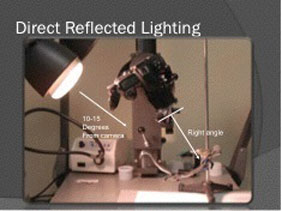 |
When capturing the IR photographic images you may experience more obstacles than when using the traditional DSLR. It may take more patience and practice, but you will likely be surprised by the results. First, set the camera mode to Aperture Priority or Manual and use a tripod or copy stand to stabilize the camera. After making sure you have an IR emitting light source, focus the lens on the subject and adjust exposure setting accordingly. If using external filters, place the filter on the camera after focusing because as you will find out, the filters are opaque and you will not be able to verify the image is in focus while the lens is in place. It is important to note that the use of an external filter may require refocusing the lens due to a shift in the focal plane. IR shift is an adjustment to the focus of the lens in order to compensate for using the filter. As a result, you may need to readjust the focus and capture additional images after previewing the quality of the first image.
Benefits to the investigator
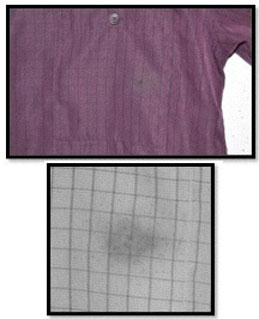 |
So, you may be wondering, what is the big deal for using IR photography at a crime scene or for evaluating physical evidence? The benefits for using IR photography generally rests in its ability to make visible a subject that would otherwise be overlooked by the naked eye or missed using traditional photography. For instance, IR photography is useful in visualizing gun shot residue (GSR), bloodstains, tattoos, obscured writing, forgery, latent prints, and counterfeiting that is not readily visible to the naked eye.
After capturing images of the scene or physical evidence using traditional photography the IR camera can then be used. For instance, while investigating a shooting incident the search for and visualization of GSR may be difficult. An individual that is shot and wearing dark clothing will present such a problem, but after using IR photography the GSR may be visualized more readily. Image 2 represents an article of dark clothing worn by a shooting victim. After using an IR camera to visualize the GSR, image 3 is the result. The image may then be used to facilitate further analysis.
Tattoos present identifiable features on individuals that may be obscured for a variety of reasons. IR photography may be used to visualize tattoos due to mass fatality situations, decomposition, coverups, laser removal, dark skin, or damaged skin. When evaluating the tattoos it is important to consider a variety of issues, such as the skin color and thickness, the ink used, the IR source, and the color of the ink.
The color and thickness of skin may impact the quality of the IR image because the longer wavelengths of light do not penetrate skin as far as shorter wavelengths, such as that of Ultra-violet light. As a result, the visualization and contrast will vary due to the depth of the tattoo inks and the color and thickness of the skin. Additionally, the type of ink can vary the results as well. Older tattoos tend to have ink that absorbs the IR, which results in stronger contrast in the image. Newer tattoo ink does not appear to have as strong of contrast as the older inks. The color of the tattoo’s ink also presents another issue to consider. Red color ink will likely vanish, but darker color inks underneath the red color may be visible. Furthermore, many darker colors may restrict visualization underneath a coverup. It is also important to consider that lighter colors or variations in the types of ink, such as new ink over old, may assist in visualizing what was covered up.
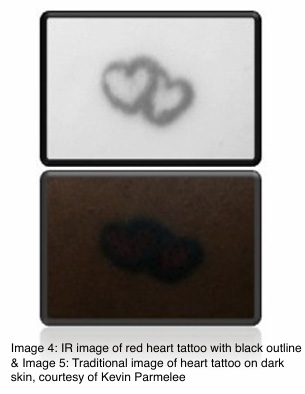
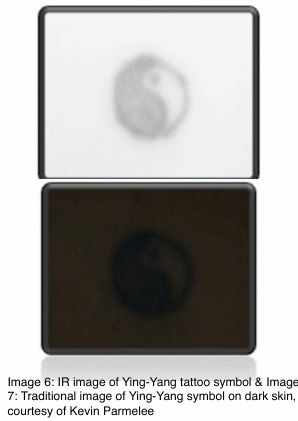
Finally, it is important to have an appropriate IR light source. The camera’s pop-up flash should be effective in most of the close situations, but in wide areas, with larger distance between the camera and subject, there should be sufficient IR light added.
IR photography is also useful in visualizing processed latent prints that may be obscured due to the colors of the substrate the print is on. Some factors for consideration include the background color and contrast, the type of medium the print is on, close-up photography techniques, equipment, and an appropriate IR light source.
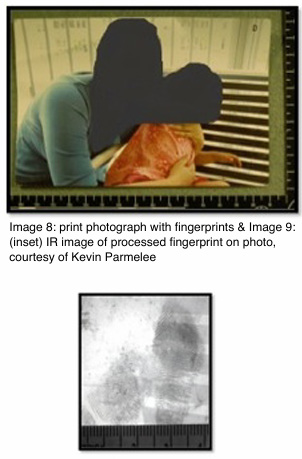
One such example is a fingerprint that is developed on a photograph, which may be obscured by the colors, contrast, and shapes of the subjects in the photo. Standard lifting of the latent lift is likely not an option due to the destruction of the print when lifting the tape from the paper photograph. Image 8 is a photograph that contains developed latent prints. Instead of lifting the print it is photographed with an IR camera, resulting in image 9.
Obscured writing due to damage or forgery of documents present additional dilemmas where the investigator may benefit from the use of IR photography. Since some inks become transparent when visualizing them with IR photography a comparison of inks may be made to determine if they were from different pens. This may assist in further examination of the evidence and assisting the investigation into potential forgery cases. Additionally, damage by heat and flame to printed pages or written pages may also be visualized by IR photography.
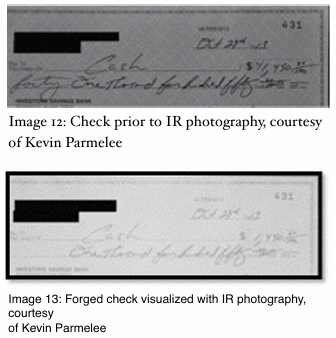
Flame and heat damage can cause significant damage to potential evidence, such as that of a typed letter or other printed material. Image 14 represents heat and flame damage to a printed page. Due to the flame and heat damage the wording may be obscured, but with the use of IR imaging the printed words may become more clear, as in image 15.
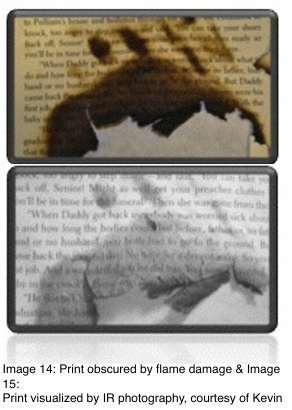
Finally, IR photography may assist in visualizing blood on dark items, or potentially visualizing items obscured by blood. For instance, blood on dark clothing may present a significant problem when photographing with a traditional camera. In image 16 the shirt has bloodstains that are barely visible to the naked eye and equally difficult to photograph with a traditional camera. Image 17 is a picture of the same shirt captured using an IR camera.
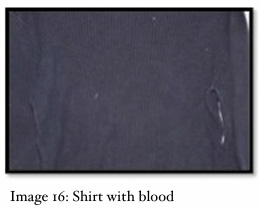
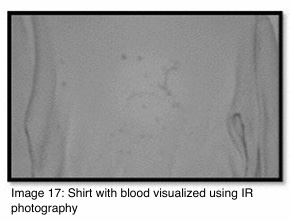
On the other hand, IR photography may aid in visualizing an item obscured by blood. Image 18 is blood obscuring the serial number of a handgun. In image 19 the serial number is clearly observed using IR photography.
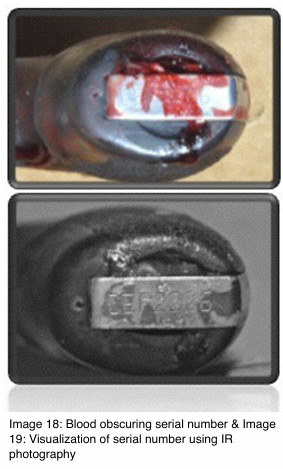
IR photography offers investigators a useful tool in visualizing items otherwise not visible, but the results are not always what is expected. Experience has shown that some dark color articles of clothing absorb the IR, much like that of the blood and GSR. As a result, there is no distinction between the blood and the rest of the surface it is on. Since there is a great deal of variation in the types of clothing and the dyes that are used to color them, it may be a case of testing the item in order to determine if IR photography will be useful.
In conclusion, IR photography offers investigators a useful tool to search for and document items that would otherwise not be readily visible. The value of the IR image is further augmented due to the ability to show attorneys, judges, and jury a better method of visually observing items of evidence that may be potentially critical to a criminal case. Investigators interested in exploring IR photography will likely find it to be a cost effective and useful tool. A digital camera can easily be converted by using one of the many companies that offer the service and filters can be obtained by any of the major camera supply companies. It is highly recommended that prior to officially using an IR camera at crime scenes or with physical evidence the individual become familiar with the equipment and methods for capturing images. Sufficient practice and proficiency will significantly reduce potential problems and maximize success in capturing high quality IR images.
References
- Clarkson, H. & Birch, W. (2013). Tattoos and human identification: Investigation into the use of x-ray and infrared radiation in the visualization of tattoos. Journal of Forensic Science. 58(5), 1264-1272.
- Robinson, E. (2010). Crime Scene Photography (2nd ed.). New York: Elsevier
About the Author

Kevin Parmelee
Kevin Parmelee is a detective for Somerset County Prosecutor’s Office Forensic Laboratory, New Jersey. His specialties include Crime Scene Investigation, Latent Print Analysis, Forensic Photography, Arson Investigations, and Footwear/Tread wear Analysis. Academically, Kevin holds a Bachelor of Science, Masters degrees in Public Administration and Human Resource Management, and a PhD in Criminal Justice. He is also certified as a Crime Scene Analyst (IAI) and Forensic Photographer (IAI). In addition to his regular work duties, Kevin is the Program Coordinator for the Northeast Crime Scene Institute, and Regional Representative and 2nd Vice-President for the NJ Division of the IAI. Kevin has provided numerous presentations and training courses for forensic science related topics and is also an Adjunct Professor at Warren County Community College. Kevin is an active member, or associate member, of the following organizations; IAI, NJ-IAI, AAFS, IAAI, ACJS, and IABPA.
Article submitted by the author.

